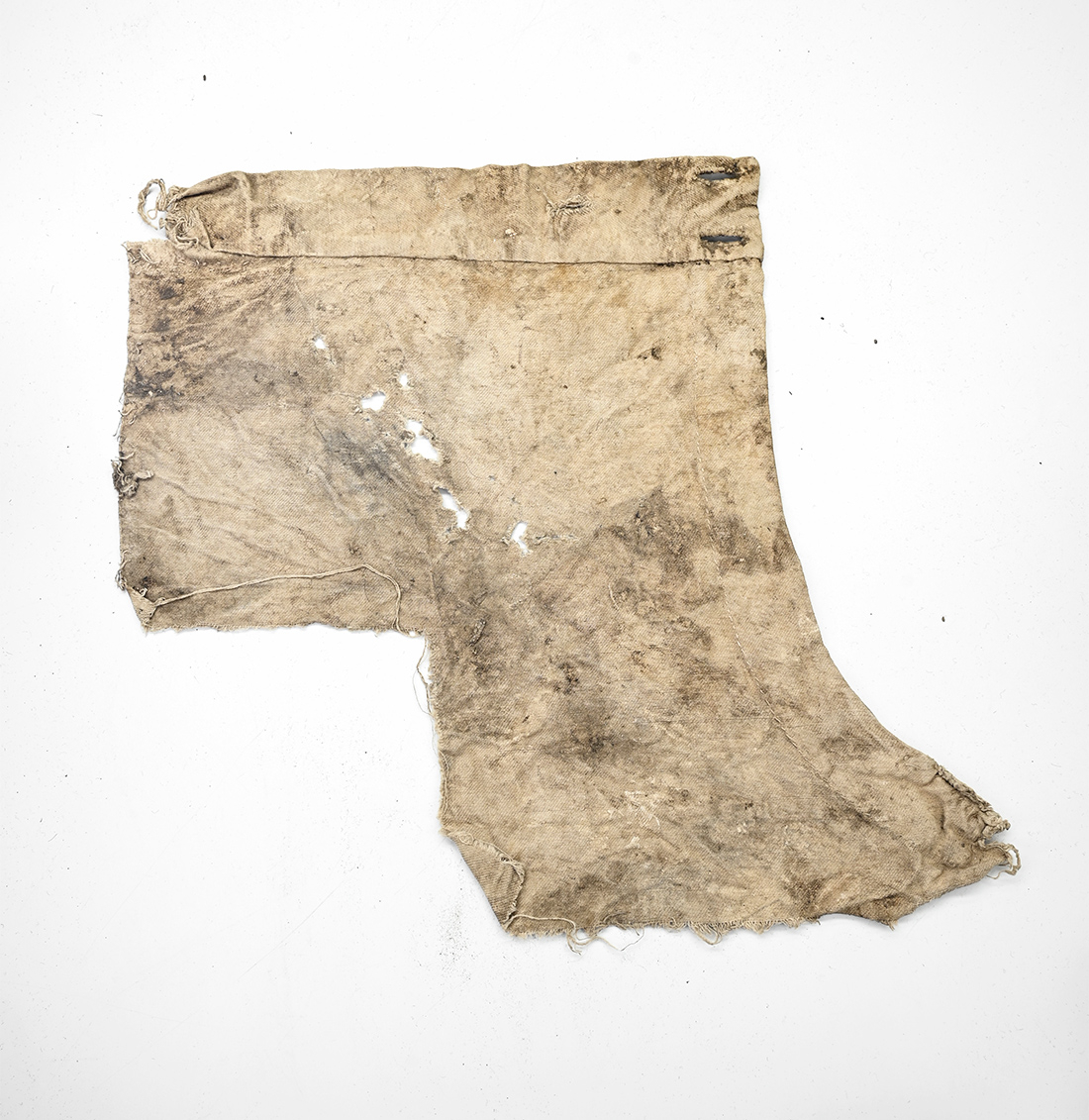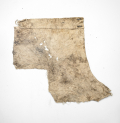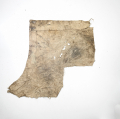site search
online catalog
CIVIL WAR U.S. ARMY ISSUE DRAWERS FRAGMENT

$225.00 SOLD
Quantity Available: None
Item Code: 1052-474
This fabric is the left front of a set of army issue drawers from the excavations at Fort Pembina, ND, conducted on private property with the owner’s permission, where wet, anaerobic soil conditions have yielded leather gear and cloth in remarkable states of preservation. This is in good condition, displayable, off-white in color with stains and a few small holes. It consists of the narrow waistband with two small buttonholes for the tinned iron buttons that would have been sewn on the other side and has a single buttonhole added slightly toward the back for an unknown purpose. It preserves the lower panel of the front, showing the curving, reinforced edge of the fly and some straight cuts indicating the soldier salvaged some of the material for patching something, using as a cleaning rag, etc., before discarding this portion.
The narrow waistband seems to fit some of the Civil War M1851 versions rather than the wide M1872 patterns. The Civil War versions varied a bit by supplier. Some NY Depot examples shows a wider waistband, but Schuylkill Arsenal apparently used a narrower band like this, with the pair in the 1858 Danish exchange looking like this. These were made in huge numbers and lasted the army for years after the war. They were characteristically cheaply made, often disliked, and hardly worth preservation as a cherished relic of wartime service. Very few survive even though US purchases are estimated at 11 million, with hundreds of thousands more made at clothing depots. Most were cotton flannel, but there were some knit, domet flannel, or other types specified in individual contracts. They were ankle length, fitted with cloth ties at the slit ankles to keep them from riding up, fastened by two buttons at the waist and laced across the open V at the rear of the waistband through sewn grommet holes for adjustment, They were issued in three sizes, which were often all too small, in one weight of material that usually left the soldier too hot or too cold. Many troops thus relied on private purchases or dispensed with them altogether. A study of a company of the 33rd Mass. on campaign indicated perhaps one man in three was not drawing issue drawers.
Fort Pembina was established in 1870 by troops of the 20th US Infantry and as is typical of the early Indian Wars regular army, their issue uniforms were Civil War surplus well into the 1870s. Situated in the Red River Valley in North Dakota near the Canadian border, Ft. Pembina was in operation until 1895. Trading posts existed earlier in the area as part of the fur trade, and the first U.S. military post there was temporary- manned by a detachment of Minnesota troops in 1863-1864 following the 1862 Sioux uprising. In March 1870 a new fort was established south of the Pembina River and about 200 yards west of the Red River, completed by July and named in honor of Gen. George H. Thomas. The name was changed to Fort Pembina in September and the initial garrison consisted of two companies of the 20th US Infantry. Their main purpose was to provide security for settlers worried about Sioux returning south from Canada, but the troops spent much of their time escorting boundary surveys along the Canadian border and preventing Fenian raids heading north into Canada.
The fort included enlisted barracks, officers’ quarters, guard house, ordnance storehouse, company kitchen, root house, laundress’s quarters, quarters for civilian employees, hospital and hospital servant’s house, a barn for the “hospital cow,” quartermaster and commissary offices and storehouse, stables, wagon shed, etc. The garrison reached peak strength in 1878 of 200, but the average was about 125 enlisted men and 8 officers. An October 1885 return listed 97 men, 2 field pieces, 1 mountain howitzer, 100 rifles, 19 pistols, 23 mules, and 9 wagons. By 1890 the post had just 23 men, and after an 1895 fire destroyed some 19 buildings it was decided to abandon the fort rather than rebuild, the last detachment left in September. The property was turned over to the Interior Department and later sold in 1902.
This piece is stable, displays very well, is a scarce relic of army life on the frontier and would make an interesting study piece of the postwar army’s material culture. [sr] [ph:m]
~~~~~~~~~~~~~~~~~~~~~~~~~~~~~~~~~~~
THIS ITEM, AS WITH ALL OTHER ITEMS AVAILABLE ON OUR WEB SITE,
MAY BE PURCHASED THROUGH OUR LAYAWAY PROGRAM.
CLICK HERE FOR OUR POLICIES AND TERMS.
THANK YOU!
Inquire About CIVIL WAR U.S. ARMY ISSUE DRAWERS FRAGMENT
For inquiries, please email us at [email protected]
Most Popular
Historical Firearms Stolen From The National Civil War Museum In Harrisburg, Pa »
Theft From Gravesite Of Gen. John Reynolds »
Cavalry Carbine Sling Swivel »
Fine Condition Brass Infantry Bugle Insignia »
featured item
REGIMENTAL STANDARD OF MERRILL’S HORSE, 2ND MISSOURI CAVALRY
Formerly in the collections of the Texas Civil War Museum, this historic flag was carried by Merrill’s Horse, the 2nd Missouri Cavalry, raised under the authority of Gen. John C. Fremont, commanding the Western Department out of St. Louis. Fremont… (1179-031). Learn More »




